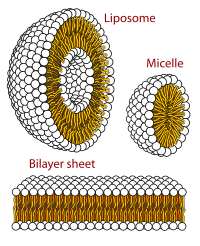
Photo from wikipedia
We have been investigating the early stages of α-synuclein (Syn) aggregation, a small presynaptic protein implicated in Parkinson's disease. We previously reported that for pH jumps (1000 s) from pH 7 to… Click to show full abstract
We have been investigating the early stages of α-synuclein (Syn) aggregation, a small presynaptic protein implicated in Parkinson's disease. We previously reported that for pH jumps (1000 s) from pH 7 to pH 2 the variation of the Syn intrinsic fluorescence intensity did not change in the concentration range of ca. 10-50 μM (ref. 16). Additionally, I reported dynamic light scattering (DLS) experiments revealing the formation of early large Syn aggregates (ref. 7). These reported results mean that some molecular entity is being early formed. Herein, it was decided to investigate in detail these early Syn aggregates by using light scattering. By DLS analysis, these aggregates exhibited a hydrodynamic diameter of ca. 420 nm along with a high scattering intensity, characteristic of micellar-like aggregates formation. The critical micelle concentration (CMC) at which the Syn micellar-like aggregates are formed was ca. 10 μM. DLS analysis has also revealed that the micellar-like aggregates for Syn evolved, for protein concentrations >100 μM, to the formation of smaller aggregates (hydrodynamic diameter of ca. 165 nm), possibly Syn oligomers. The Syn micellar-like aggregates formed at pH 7 solutions seem to be active species and to have a role in this protein aggregation mechanism.
Journal Title: International journal of biological macromolecules
Year Published: 2021
Link to full text (if available)
Share on Social Media: Sign Up to like & get
recommendations!